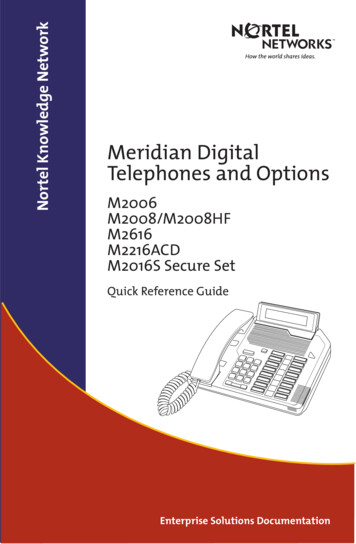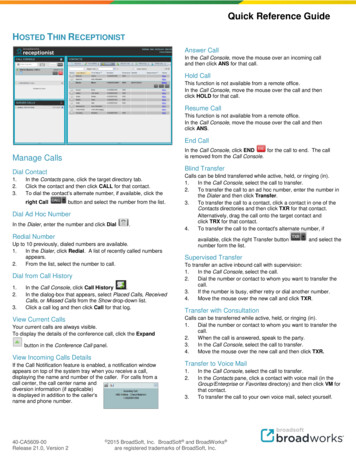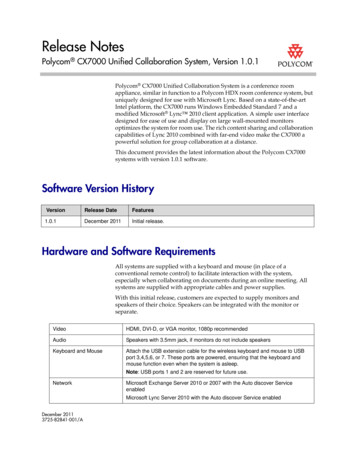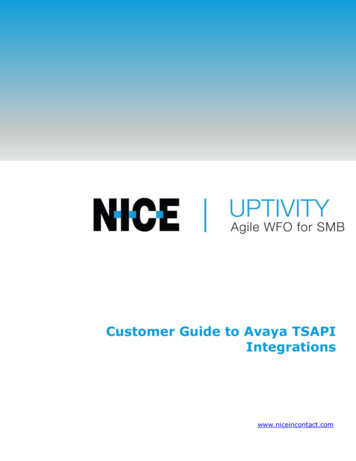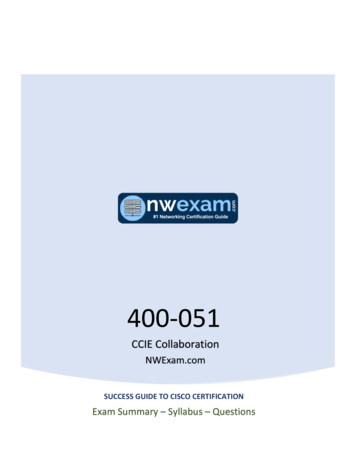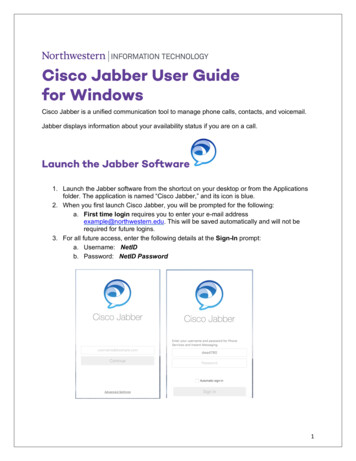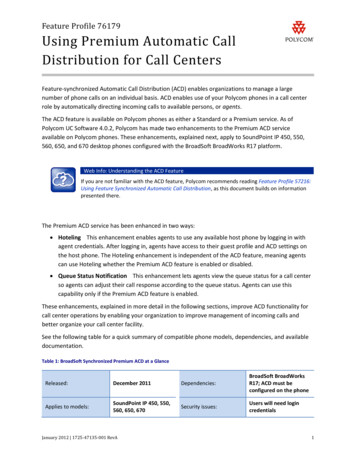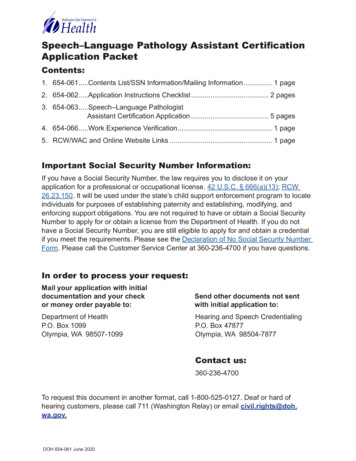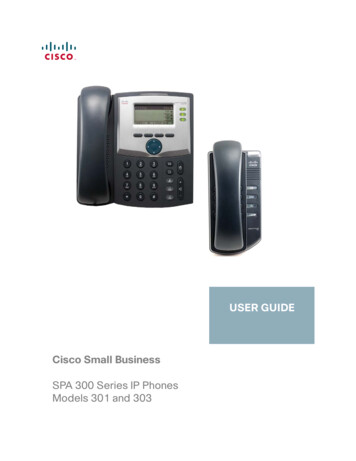
Transcription
Call Me by Your Name: The Effect of Analyst-CEO First Name Commonality onAnalyst Forecast AccuracyOmri Even-TovHaas School of Business, UC-BerkeleyKanyuan HuangUCLA Anderson School of ManagementandBrett TruemanUCLA Anderson School of ManagementApril 2020AbstractIn this paper we document that the earnings forecasts of security analysts who share afirst name with the CEO of a covered firm (referred to as ‘matched’ analysts) are more accurate,on average, than those of analysts who do not share a first name (referred to as ‘unmatched’analysts). This result is consistent with findings in psychology which show that individuals havean affinity for those who share first names and suggests that the CEO is more likely to shareprivate information with a matched analyst. We find this phenomenon to be concentrated amongthose matched analysts with less common first names, perhaps because the salience of sharing afirst name is lower for analysts with more common names. It is also stronger in situations wherethere is greater information asymmetry between management and analysts.JEL Codes: G14, G24, G40, M41Keywords: security analysts, earnings forecast accuracy, first namesWe thank David Aboody, Jennifer Chatman, David Hirshleifer, Laura Kray, Ross Levine, DonMoore, Sameer Srivastava, Siew Hong Teoh, Catherine Wolfram, Jieyin Zeng, and seminarparticipants at UC-Berkeley for helpful comments.Electronic copy available at: https://ssrn.com/abstract 3569247
“Using data on nearly four million speeding tickets in Florida, we examined whethersomething as trivial as having the same first name as a police officer could affect a driver’slikelihood of receiving a costly speeding ticket.It can.” 1I. IntroductionAs illustrated by the above quote from a New York Times article, names play animportant, and sometimes outsized, role in society. Research in accounting and finance is repletewith examples of this. Jung, Kumar, Lim, and Yoo (2019), for instance, find that the perceivedfavorability of an individual analyst’s surname can predict the price reaction to the analyst’sforecast revisions, despite there being no significant association between forecast accuracy andsurname favorability. Kumar, Niessen-Ruenzi, and Spalt (2015) document that the flow of fundsinto U.S. mutual funds is significantly lower for managers with foreign-sounding surnames thanfor those with American-sounding surnames, holding fund performance constant. Tan, Xiao,Zeng, and Zou (2018) document a negative relation between the sharing of surnames among themembers of a firm’s board of directors and firm value, suggesting that surname sharing createspersonal ties between otherwise unrelated persons, compromising board effectiveness. Cooper,Dimitrov, and Rau (2001) find that during the dot com boom, changing a firm’s name to anInternet-related name elicited a positive price reaction, regardless of the firm’s involvement withthe Internet, while Cooper, Gulen, and Rau (2005) document that mutual funds that changedtheir name to reflect a currently-hot investment style received an influx of funds, even thoughperformance did not improve. 21“The Benefit of Having the Same Names as a Police Officer,” New York Times, August 5, 2018, Section SR, p. 9.There is another literature that examines the effect of corporate names and corporate stock tickers on financialmarkets. For example, Green and Jame (2013) find that firms whose names are considered to be more fluent areassociated with greater breadth of ownership, greater liquidity, and higher Tobin’s q and market-to-book ratios.Xing, Anderson, and Hu (2016) find a positive association between the likeability/pronounceability of a firm’s stockticker and its Tobin’s q ratio.22Electronic copy available at: https://ssrn.com/abstract 3569247
In this paper we examine whether an analyst’s earnings forecast accuracy is affected bywhether the analyst and the firm’s CEO share a first name. Our work is grounded in research inpsychology which suggests that people have a greater liking of, and attraction to, individualswith a first name similar to their own and a greater willingness to respond favorably to requestsmade by such individuals. (See Jones, Pelham, Mirenberg, and Carvallo, 2004, and Garner,2005.) This finding is considered to be a manifestation of implicit egotism, whereby individualsexpress a preference for people, places, and things that they unconsciously associate withthemselves (see, for example, Jones, Pelham, Mirenberg, and Hetts, 2002, and Pelham,Mirenberg, and Jones, 2002). 3 We conjecture that the greater affinity arising from the sharing ofa first name will lead to a greater willingness on the part of the CEO to share private informationwith an analyst and will, in turn, manifest itself in increased forecast accuracy.To test this, we use the annual earnings forecasts issued by analysts between 1992 and2018. For each firm and year, we calculate the forecast accuracy of each analyst covering thatfirm relative to that of all other analysts covering the firm that year. Consistent with ourconjecture, we find that the relative accuracy of forecasts issued by analysts with the same firstname as that of the firm’s CEO is significantly greater, on average, than that of forecasts issuedby analysts with a first name different from that of the CEO. Further, for a given analyst we find3This phenomenon appears to be quite pervasive. Nuttin (1985) found that individuals have a preference for theletters in their own name, especially the initials of their first and last names. (This is called the “name letter effect.”)Kooti, Magno, and Weber (2014) found that Twitter users are more likely to follow other users with the same firstname than to follow users with other names. Jones et al. (2004) found that people were disproportionately morelikely to marry someone sharing the beginning letters of their first name (for example, James is more likely to marryJuliette than to marry Deborah; David is more likely to marry Daniel than to marry Adam). Pelham et al. (2002)provided evidence that individuals are more likely to choose a profession whose name shares the first few letterswith the individuals’ first name (for example, Denny is more likely to be a dentist than a lawyer; Laura is morelikely to be a lawyer than an engineer). Gallucci (2003) and Simonsohn (2011) questioned some of the conclusionsin Pelham et al. (2002) regarding the link between names and major life decisions. Pelham, Carvalo, DeHart, andJones (2003) and Pelham and Carvalo (2011) provided rebuttals.3Electronic copy available at: https://ssrn.com/abstract 3569247
that relative forecast accuracy is higher, on average, for those covered firms where the analyst’sfirst name matches that of the CEO than for those where there is no match.To provide further support for our results, we examine the change in forecast accuracywhen there is CEO turnover. At such a time, previously matched analysts become unmatched(except in the rare circumstance where the new CEO has the same first name as the previousone), while some previously unmatched analysts may become matched. We expect the relativeforecast accuracy of the former group to decrease post-turnover, while that of the latter group toincrease. Both of these conjectures are borne out by the data, supporting our conclusion that therelative forecast accuracy of matched analysts exceeds, on average, that of unmatched analysts.To rule out the possibility that ethnic and/or gender ties are driving the observedforecasting superiority of matched analysts, we add controls for ethnic and gender ties into ouranalysis. Doing so, we find that the forecast accuracy of matched analysts remains significantlygreater than that of unmatched analysts. As an alternative test, we exclude from our sample allanalyst-CEO pairs in which both are either women or have the same ethnicity. Again, we findthat matched analysts exhibit significantly greater forecast accuracy than do unmatched analysts.These findings allow us to conclude that neither gender nor ethnic ties are driving our results.Analysts and CEOs with very common first names are accustomed to meeting peoplewith the same name; for them, the salience of sharing a first name is likely to be lower. As aresult, we expect that the positive effect of a first name match on relative forecast accuracy willbe more pronounced the less common that name. To test this we partition our matched namesubsample into two groups – analysts with more common names and analysts with less commonnames, using data on first name frequency provided by the Social Security Administration. Wefind that the forecasts of the matched analysts with less common names are significantly more4Electronic copy available at: https://ssrn.com/abstract 3569247
accurate than are those of unmatched analysts. In contrast, the relative accuracy of the forecastsof the matched analysts with more common names is not significantly different from that ofunmatched analysts. These results are consistent with our expectations.If matched analysts have access to private information, then we would expect theirforecasting superiority to be greater when there is more information asymmetry between theCEO and analysts. We examine this by partitioning our sample into those firm-years wheremanagement has issued their own earnings forecast (which would lessen informationasymmetry) and those where they have not. Consistent with our conjecture, we find that theforecast accuracy of matched analysts is significantly higher than that of unmatched analystswhen there is no management forecast. In contrast, there is no significant difference in accuracywhen a management forecast has been released. For the set of firm-years without managementforecasts, we go one step further and partition firms according to market capitalization. Weexpect information asymmetry to be higher among the relatively smaller firms and, therefore, forthere to be a greater effect of a first name match on relative forecast accuracy. Again consistentwith our conjecture, matched analysts’ forecast accuracy is significantly higher than that ofunmatched analysts for the smaller firms in our sample, but not for the largest firms.We conjecture that the superior forecasting accuracy of a matched analyst relative to thatof an unmatched analyst will decrease as analyst experience covering the firm increases. Thereare two reasons why this might happen. The first is that as analysts, whether matched orunmatched, gain experience with a covered firm, their expertise in forecasting earnings increases(see Clement, 1999, and Mikhail, Walther, and Willis, 1997), thereby reducing the importance ofsharing a first name with the CEO. The second is that, as time passes, the affinity between ananalyst and CEO due just to their sharing of a first name may lessen. This is consistent with the5Electronic copy available at: https://ssrn.com/abstract 3569247
finding of List (2003) that, in a market setting, psychological biases diminish with participantexperience. Our conjecture is supported by the data; compared to non-matched analysts with thesame experience covering the same firm, the forecast superiority of matched analysts decreasesover time.Our analysis further reveals that the matched analysts’ forecasting superiority remainssignificant after the implementation of Regulation Fair Disclosure (Reg FD). This regulationprohibits public firms from selectively disclosing ‘material’ private information to marketprofessionals and certain shareholders. If Reg FD was fully effective, then matched analysts’forecasting superiority should have disappeared after its implementation. There is reason tobelieve, though, that Reg FD has not completely halted the selective disclosure of materialinformation. This is because the regulation does not prohibit management from meetingprivately with an individual analyst to discuss details of the business, which may allow theanalyst to complete a ‘mosaic’ of information that could be material to the analyst (see CooleyGodward, 2000). These meetings also allow the analyst to take advantage of nonverbalcommunication in order to make inferences about the manager’s private information (see thesurvey results of Brown, Call, Clement, and Sharp, 2015). Empirical evidence consistent withthis is provided by Bushee, Jung, and Miller (2013) who find that investors make profitabletrades subsequent to one-on-one meetings with managers at invitation-only investor conferences,even after the implementation of Reg FD. Additionally, Solomon and Soltes (2013), using adataset of one-on-one meetings for a NYSE-traded firm, find that those investors who meetprivately with management make more informed investment decisions. That matched analysts’forecasting superiority remains after the implementation of Reg FD provides additional6Electronic copy available at: https://ssrn.com/abstract 3569247
suggestive evidence that the regulation has not been completely effective at prohibiting theselective dissemination of private information.Our work contributes to a body of research examining the effect of shared characteristicsbetween analysts and CEOs on analysts’ forecasts and recommendations. Jannati, Kumar,Niessen-Ruenzi, and Wolfers (2016), for example, find that male analysts issue more optimisticforecasts for firms with male CEOs than for firms with female CEOs. They also find thatconsensus forecasts are higher for firms with domestic CEOs and for firms with CEOs whosepolitical contributions are made predominantly to the Republican party. The authors explainthese latter results by noting that most analysts in the IBES database are American and that mostof them donate primarily to the Republican party. Cohen, Frazzini, and Malloy (2010) show thatthe buy recommendations issued by analysts graduating from the same university as one of thesenior officers of the firm that is being recommended significantly outperform those of analystswho do not have a university connection. 4 The authors conjecture that this superior performancestems from the willingness of firm management to share private information with analysts withwhom they have university ties. They present evidence consistent with their conjecture. 5The structure of this paper is as follow. In section 2 we discuss our sample constructionprocedure. Variable definitions and descriptive statistics are presented in section 3. Our analysis4No significant difference in performance is found for sell recommendations. They also do not find any differencesbetween the accuracy of earnings forecasts issued by analysts who share a university tie and those issued by analystswho do not.5The impact of social ties has been studied in other settings as well. For example, Hwang and Kim (2009) find thatcorporate boards where a majority of directors have a tie with the firm’s CEO (alma mater, military service, regionalorigin, academic discipline, or industry) award higher pay to that CEO than do boards whose members do not havethese ties. Cohen, Frazzini, and Malloy (2008) find that mutual fund managers make larger investments in firms forwhich they share a university tie with a senior official. The mutual fund managers also earn a significantly higherreturn on their investment in those firms, suggesting that there is a flow of private information from the firm to fundmanagers when there exists a university tie.7Electronic copy available at: https://ssrn.com/abstract 3569247
of forecast accuracy for matched and unmatched analysts appears in section 4. A summary andconclusions section ends the paper.II. Sample ConstructionTable I summarizes the process of arriving at our final sample. Our initial sampleconsists of the approximately 1.9 million annual earnings forecasts that are recorded in the IBESforecast database over the period 1992 through 2018 and for which the name of the firm’s CEOappears in the Execucomp database (which covers the S&P 1500 firms). Of these forecasts, weretain only those for whom we can determine the first name of the analyst issuing the forecast.The forecast database does not directly allow us to ascertain the analyst’s first name since it onlycontains an analyst code. To find the analyst’s name, we use the IBES recommendationsdatabase, which provides the analyst code and analyst last name and first initial for each analystwho has issued a recommendation. Using the analyst’s last name and first initial, and the nameof the firm for which the analyst worked, we search the Capital IQ database, as well as consultvarious Internet sources (such as LinkedIn) to find the analyst’s full first name. We are able toidentify the first name of the analysts for about half of our initial sample of forecasts. From thatreduced sample, we delete forecasts with missing announcement date, those issued either afterthe earnings announcement or more than a year before the earnings announcement, and forecastsfor which the earnings announcement date is more than six months after the fiscal year-end.This leaves us with 904,748 annual earnings forecasts. Of these forecasts, we retain just the lastforecast issued by an analyst for a given fiscal year. If a firm-year has fewer than five analystsdisseminating forecasts, that firm-year is dropped from our sample. 6 After dropping those6Dropping only those observations with fewer than three analysts does not affect our results.8Electronic copy available at: https://ssrn.com/abstract 3569247
observations, the final number of last-of-the-year annual earnings forecasts in our sample is193,698.In determining whether an analyst and CEO have the same first name, we allow forvariations in spelling. (Our results hold if we restrict matches to be those where the names arespelled identically.) For example, an analyst with the name Allen is considered to share a firstname with a CEO named Allan and with a CEO named Alan; an analyst with the name Steven isconsidered to share a first name with a CEO named Stephen. We do not extend this tonicknames, though; an analyst and CEO are not considered to have the same first name if oneuses a formal first name and the other uses a nickname of that formal first name. For example,an analyst with the name David is not considered to share a first name with a CEO named Dave.One reason for not extending matches to nicknames is that it is not always clear what nicknamesare associated with any given name. Another reason is that two formal names might share onenickname. For example, Al could be a nickname for both Allen and Albert. It is unclear thatAllen and Albert would consider themselves to have the same first name.As reported in Table II, panel A, our final sample is comprised of 4,890 unique equityanalysts, 592 (12.1%) of whom share their first name with at least one CEO at some point duringthe analyst’s career. Our sample also consists of 4,380 unique CEOs, 677 (15.5%) of whomshare their first name with at least one analyst at some point during the CEO’s tenure. There are69,514 unique analyst-CEO pairs, of which 921 (1.3%) share their first names. Table II, panel Blists all of the matched names, and the number of times that each name appears as part of amatch. As seen in the table, the top five names, John, David, Michael, James, and Robertcomprise approximately 53% of all of the matched names.9Electronic copy available at: https://ssrn.com/abstract 3569247
III. Variable definitions and descriptive statisticsIII. a. Dependent variableOur dependent variable is relative forecast accuracy. For each analyst i covering firm f inyear t, we first calculate the analyst’s earnings forecast error for the firm in that year, FEift . It isequal to the difference between the firm’s realized earnings for that year and the analyst’s lastannual earnings forecast preceding the release of those earnings. (Using the analyst’s lastforecast prior to the end of the period is common in empirical studies. See, for example,Clement, 1999, Clement and Tse, 2005, O’Brien, 1990, and Sinha, Brown, and Das, 1997.) Theanalyst’s relative forecast accuracy, RFAift , is then given by:RFAift Abs ( FEift ) Abs ( FE ft )Abs ( FE ft )(1)where Abs ( FEift ) is the absolute value of FEift and Abs ( FE ft ) is the average of the absoluteforecast errors of all the analysts following firm f in year t. (This is the same measure of relativeforecast accuracy used by Clement, 1999, Malloy, 2005, and Bae, Stulz, and Tan, 2008.) Anegative (positive) value of RFAift reflects a forecast that is more (less) accurate than theaverage. For our analysis we winsorize observations of relative forecast error at the 99thpercentile. If Abs ( FE ft ) is equal to zero, meaning that all analysts have a zero forecast error, weset RFAift equal to 0. 7 As reported in Table III, the mean value of RFA is zero (by definition),and ranges from -1 (when the analyst’s forecast error is zero) to a maximum value of 18.85.7There are very few such observations. Excluding them from our analysis has no impact on our results.10Electronic copy available at: https://ssrn.com/abstract 3569247
III. b. Independent VariablesThere are several independent variables that are common across all or most of ourregressions. The first is MATCH ift , which is an indicator variable equal to one if analyst i hasthe same first name (as defined above) as the CEO of covered firm f in year t, and is equal tozero, otherwise. 8 Of the 193,698 forecasts in our sample, 1.4% of them were issued by matchedanalysts (untabulated). Our next independent variable is COMMON i , which is an indicatorvariable equal to one if analyst i’s first name is classified as common (as defined below), and isequal to zero, otherwise. We control for name commonness in our analysis because matchednames are also likely to be common names. Research in psychology has found that individualswith common names are considered more attractive and are more liked than those withuncommon names (Crisp, Apostal, and Luessenheide, 1984, West and Shults, 1976, Lawson,1971, Mehrabian, 1992, 1997, and Christopher, 1998). Being more liked, they may getpreferential treatment in hiring (see Cotton, O’Neill, and Griffin, 2008). If so, this would suggestthat the qualifications of analysts hired with common names might not be as strong as thequalifications of those hired with uncommon names, which could lead to lower forecast accuracyfor the former set of analysts.To determine whether a first name is common, we collect data from the Social SecurityAdministration on the distribution of first names of those born in each decade from the 1950sthrough the 1980s. 9 We classify names with a frequency of 2% or higher as more common (orsimply “common”) names and those with a frequency of less than 2% as less common(alternatively, “uncommon”) names. We do this separately for male and female names. In8For a firm that experiences CEO turnover in year t, the CEO that we use for our analysis is the person who servedin that position for the longest period of time during the year.9See tml.11Electronic copy available at: https://ssrn.com/abstract 3569247
determining these frequencies, we do not aggregate spelling variants of a given name. 10 Todetermine whether an analyst has a more common or less common name, we assume that eachanalyst is 30 years old when first appearing on IBES and then check whether the analyst’s firstname was above or below 2% in frequency 30 years prior to the analyst’s first appearance onIBES. We recognize that the choices of a cutoff frequency of 2% and a 30-year look-back periodare arbitrary. To ensure the robustness of our results, we alternatively (1) use a cutoff frequencyof 1.5% and (2) rerun our analysis, using a definition of commonness based on the frequency ofanalyst first names in the IBES database (see Section IV. a).Our next independent variable, HORIZON ift , is the number of calendar days between thelast forecast of analyst i for covered firm f during year t and the date of the release of the firm’searnings for the year. The mean number of days between the last forecast and the earningsrelease is 108, ranging from a low of one day to a high of 364 days. The variable EXPit is thenumber of years of experience that analyst i has had as an analyst as of year t, starting from theyear in which the analyst first appears on IBES. Analysts in our sample have, on average, 11years of experience, with a maximum of 37 years. The variable # FIRMSit is equal to thenumber of firms for which analyst i has issued at least one forecast of annual earnings duringyear t. On average, the number of firms covered by a single analyst is 17.4, with a low of 1 and ahigh of 107. 11 All of the definitions of these dependent and independent variables appear in theAppendix. There are other independent variables that are specific to particular regressions; theyare defined as they are introduced.10There is a fair degree of stability in the common first names of males over the decades; the five most commonfirst names among males in the 1950s remain on the top-10 lists for all the decades. This is not true for the commonfirst names among females; no name appears on the top-10 lists for all four decades (untabulated).11Such a large number of covered firms likely reflects cases where a top analyst at a firm puts his or her name onthe reports that were actually written by a number of different associates in the firm.12Electronic copy available at: https://ssrn.com/abstract 3569247
IV. Analyst forecast accuracyIV. a. Central resultsWe begin by estimating the following regression:α 0 α1MATCH ift α 2 HORIZON ift α 3 EXPit α 4 # FIRMSit α 5COMMON iRFAift βt Year dummy variables γ f Firm dummy variables ε ift(2)where all variables have been defined in the previous section. In this regression we include yearand firm fixed effects. The results of estimating this regression are reported in column 1 ofTable IV. The coefficient on MATCH is significantly negative. As conjectured, the relativeaccuracy of an analyst’s forecast is significantly greater when that analyst shares a first namewith the firm’s CEO than when they have different first names. The magnitude of thecoefficient, -0.049, means that having the same name as a CEO is associated with a 4.9percentage point increase in an analyst’s relative accuracy as compared to having a differentname. The magnitude of the matched analysts’ relative accuracy advantage is similar to that oflocal analysts over non-local analysts, as documented in Bae et al. (2007).As expected, the coefficient on HORIZON is significantly positive, indicating that ananalyst’s forecast is more accurate the closer in time it is issued relative to the date of theearnings announcement. Also as expected, the coefficient on EXP is significantly negative,meaning that an analyst’s forecast accuracy increases with experience. The coefficient on#FIRMS is significantly negative, indicating that relative forecast accuracy increases with thenumber of firms that an analyst covers. This result stands in contrast to some other studies in theliterature, which have found a negative relation between forecast accuracy and the number ofcovered firms. It should be noted, though, that the magnitude of the coefficient is small,suggesting that the economic effect of the number of firms covered on relative forecast accuracyis marginal. The coefficient on the indicator variable COMMON is significantly positive; the13Electronic copy available at: https://ssrn.com/abstract 3569247
relative accuracy of the forecasts of analysts with more common names is lower than that ofanalysts whose names are less common. Consistent with prior research showing that individualswith common names have an advantage in the hiring process, this result suggests that analystswith common names who are hired are less qualified, in general, than are those with uncommonnames, leading to lower forecast accuracy for the common-named analysts.To control for differences across analysts in the timing of their last forecast of the year,we re-estimate regression (2) using only those last forecasts that are issued within 120 days ofthe earnings announcement. This restriction causes us to lose about one-third of ourobservations. (Using an even shorter interval of 90 days would have caused us to lose aboutthree-quarters of our original sample.) In untabulated results, we find that the relative accuracyof the forecasts of the matched analysts remains significantly higher, on average, than that of theunmatched analysts when we narrow the variation in forecast horizons across analysts in thismanner (p-value 5%).To validate that our results are not driven by analyst-specific effects, we examinewhether, for a given analyst-year, the forecasts for firms in which the analyst’s first namematches that of the CEO are more accurate than those for which there is no match. To do so, were-estimate regression (2), replacing the year fixed effect in the regression with an analyst-yearfixed effect. We drop the independent variables for analyst experience and number of firmscovered, along with the common name indicator variable, since they are constant for eachanalyst-year. The results of re-estimating this regression are reported in column 2 of Table IV.Consistent with our prior results, the relative accuracy of an analyst’s forecasts is greater for thesubset of firms where the analyst’s first name matches that of the CEO than for the subset offirms where it does not.14Electronic copy available at: https://ssrn.com/abstract 3569247
CEO turnover provides an additional means by which to test whether a matched name isassociated with higher relative forecast accuracy. Given our prior finding that matched analystsprovide more accurate forecasts, we expect that following a change in CEO, previously matchedanalysts who are now unmatched wil
Haas School of Business, UC-Berkeley . Kanyuan Huang . UCLA Anderson School of Management . and . Brett Trueman . UCLA Anderson School of Management . April 2020 . Abstract . In this paper we document that the earnings forecasts of security analysts who share a first name with the CEO of a covered firm (referred to as 'matched' analysts .
